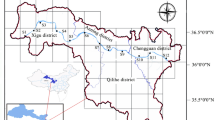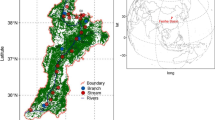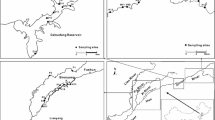Abstract
This study systematically analyzed the contents, compositions, and sources of polycyclic aromatic hydrocarbons (PAHs) in river sediments near an important energy and chemical base in northwest China. In addition, their possible adverse effects on the ecology and human health were assessed. The PAH concentrations in this study area ranged from 2641.28 to 16783.72 (ng/g dw). PAHs of medium molecular weight (3-ring and 4-ring) showed the largest proportion, followed by PAHs of higher molecular weight (5-ring and 6-ring). The results of molecular diagnostic ratios and principal component analysis revealed that PAHs in the region have complex sources, with incomplete combustion of local fossil fuels and traffic exhaust factors being the main sources. The total toxic equivalent concentration of PAHs varied from 10.05 to 760.26 ng/g, and according to the sediment quality guidelines, PAHs have high potential ecological risk in the lower reaches of the river. The mean effect range-median quotient for the region was 0.46, and the combined ecological risk was at moderate to high levels (21% probability of toxicity). The lifetime carcinogenic risks for adults and children exposed to PAHs were 2.95 × 10−3 and 1.87 × 10−2, respectively, which are much higher than the limit of 10−4, indicating moderate to high potential cancer risks. Therefore, the local government should consider taking some environmental remediation measures. This study can provide theoretical support for pollution prevention measures and ecological restoration strategies for rivers in resource-rich areas.
Graphical abstract





Similar content being viewed by others
References
Aghadadashi, V., Mehdinia, A., Bakhtiari, A. R., Mohammadi, J., & Moradi, M. (2019). Source, spatial distribution, and toxicity potential of polycyclic aromatic hydrocarbons in sediments from Iran’s environmentally hot zones, the Persian Gulf. Ecotoxicology and Environmental Safety, 173, 514–525. https://doi.org/10.1016/j.ecoenv.2019.02.029
Barhoumi, B., Beldean-Galea, M. S., Ai-Rawabdeh, A. M., Roba, C., Martonos, I. M., Balc, R., Kahlaoui, M., Touil, S., Tedetti, M., & Driss, M. R. (2019). Occurrence, distribution and ecological risk of trace metals and organic pollutants in surface sediments from a Southeastern European river (Someu Mic River, Romania). Science of the Total Environment, 660, 660–676. https://doi.org/10.1016/j.scitotenv.2018.12.428
Boonyatumanond, R., Wattayakorn, G., Togo, A., & Takada, H. (2006). Distribution and origins of polycyclic aromatic hydrocarbons (PAHs) in riverine, estuarine, and marine sediments in Thailand. Marine Pollution Bulletin, 52, 942–956. https://doi.org/10.1016/j.marpolbul.2005.12.015
Canadian, T., Quality, S. (2007). Canadian soil quality guidelines for the protection of environmental and human health total chromium SUMMARY. https://www.mendeley.com/catalogue/f32ea3a1-298f-3a48-af8e-80e2bd51f26d/
Chen, X., Liu, X., Liu, M., Yang, Y., Wu, S., & Wang, C. (2018). Molecular characterization of PAHs based on land use analysis and multivariate source apportionment in multiple phases of the Yangtze estuary, China. Environmental Science-Processes & Impacts, 20, 531–543. https://doi.org/10.1039/c7em00580f
Chiu, T. R., Khan, M. F., Latif, M. T., Nadzir, M. S. M., Hamid, H. H. A., Yusoff, H., & Ali, M. M. (2018). Distribution of Polycyclic Aromatic Hydrocarbons (PAHs) in Surface Sediments of Langkawi Island, Malaysia. Sains Malaysiana, 47, 871–882. https://doi.org/10.17576/jsm-2018-4705-02
Corminboeuf, A., Montero-Serrano, J.-C., & St-Louis, R. (2021). Spatial and temporal distributions of polycyclic aromatic hydrocarbons in sediments from the Canadian Arctic Archipelago. Marine Pollution Bulletin, 171, 112729. https://doi.org/10.1016/j.marpolbul.2021.112729
Corminboeuf, A., Montero-Serrano, J.-C., St-Louis, R., Dalpe, A., & Gelinas, Y. (2022). Pre- and post-industrial levels of polycyclic aromatic hydrocarbons in sediments from the Estuary and Gulf of St. Lawrence (eastern Canada). Marine Pollution Bulletin, 174, 113219. https://doi.org/10.1016/j.marpolbul.2021.113219
Deng, W., Li, X. G., Li, S. Y., Ma, Y. Y., & Zhang, D. H. (2013). Source apportionment of polycyclic aromatic hydrocarbons in surface sediment of mud areas in the East China Sea using diagnostic ratios and factor analysis. Marine Pollution Bulletin, 70, 266–273. https://doi.org/10.1016/j.marpolbul.2013.02.032
Froger, C., Saby, N. P. A., Jolivet, C. C., Boulonne, L., Caria, G., Freulon, X., de Fouquet, C., Roussel, H., Marot, F., & Bispo, A. (2021). Spatial variations, origins, and risk assessments of polycyclic aromatic hydrocarbons in French soils. The Soil, 7, 161–178. https://doi.org/10.5194/soil-7-161-2021
Gbeddy, G., Egodawatta, P., Goonetilleke, A., Akortia, E., & Glover, E. T. (2021). Influence of photolysis on source characterization and health risk of polycyclic aromatic hydrocarbons (PAHs), and carbonyl-, nitro-, hydroxy- PAHs in urban road dust. Environmental Pollution, 269, 116103. https://doi.org/10.1016/j.envpol.2020.116103
Gbeddy, G., Egodawatta, P., Goonetilleke, A., Ayoko, G., & Chen, L. (2020). Application of quantitative structure-activity relationship (QSAR) model in comprehensive human health risk assessment of PAHs, and alkyl-, nitro-, carbonyl-, and hydroxyl-PAHs laden in urban road dust. Journal of Hazardous Materials, 383, 121154. https://doi.org/10.1016/j.jhazmat.2019.121154
Gdara, I., Zrafi, I., Balducci, C., Cecinato, A., & Ghrabi, A. (2017). Seasonal distribution, source identification, and toxicological risk assessment of polycyclic aromatic hydrocarbons (PAHs) in sediments from Wadi El Bey watershed in Tunisia. Archives of Environmental Contamination and Toxicology, 73, 488–510. https://doi.org/10.1007/s00244-017-0440-7
Han, B., Liu, A., Gong, J., Li, Q., He, X., Zhao, J., & Zheng, L. (2021). Spatial distribution, source analysis, and ecological risk assessment of polycyclic aromatic hydrocarbons (PAHs) in the sediments from rivers emptying into Jiaozhou Bay, China. Marine Pollution Bulletin, 168, 112394. https://doi.org/10.1016/j.marpolbul.2021.112394
He, Y., Meng, W., Xu, J., Zhang, Y., & Guo, C. (2016). Spatial distribution and potential toxicity of polycyclic aromatic hydrocarbons in sediments from Liaohe River Basin, China. Environmental Monitoring and Assessment, 188, 193. https://doi.org/10.1007/s10661-016-5201-y
Huang, L., & Batterman, S. A. (2014). Multimedia model for polycyclic aromatic hydrocarbons (PAHs) and nitro-PAHs in Lake Michigan. Environmental Science & Technology, 48, 13817–13825. https://doi.org/10.1021/es503137b
Huang, Y., Li, K., Liu, H., Yuan, X., Li, M., Xiong, B., Du, R., Johnson, D. M., & Xi, Y. (2021). Distribution, sources and risk assessment of PAHs in soil from the water level fluctuation zone of Xiangxi Bay, Three Gorges Reservoir. Environmental Geochemistry and Health, 44, 2615–2628. https://doi.org/10.1007/s10653-021-01047-1
Huang, Z., Liu, Y., Dai, H., Gui, D., Hu, B. X., & Zhang, J. (2022). Spatial distribution and source apportionment of polycyclic aromatic hydrocarbons in typical oasis soil of north-western China and the bacterial community response. Environmental Research, 204, 112401. https://doi.org/10.1016/j.envres.2021.112401
Iwegbue, C. M. A., Irerhievwie, G. O., Tesi, G. O., Olisah, C., Nwajei, G. E., & Martincigh, B. S. (2021). Polycyclic aromatic hydrocarbons (PAHs) in surficial sediments from selected rivers in the western Niger Delta of Nigeria: Spatial distribution, sources, and ecological and human health risks. Marine Pollution Bulletin, 167, 112351. https://doi.org/10.1016/j.marpolbul.2021.112351
Jafarabadi, A. R., Bakhtiari, A. R., Yaghoobi, Z., Yap, C. K., Maisano, M., & Cappello, T. (2019). Distributions and compositional patterns of polycyclic aromatic hydrocarbons (PAHs) and their derivatives in three edible fishes from Kharg coral Island, Persian Gulf, Iran. Chemosphere, 215, 835–845. https://doi.org/10.1016/j.chemosphere.2018.10.092
Jing, L., Jun, L. Y., Zhe, L., Aining, Z., & Yu, L. (2018). Source apportionment of soil PAHs and human health exposure risks quantification from sources: The Yulin National Energy and Chemical Industry Base, China as case study. Environmental Geochemistry and Health, 41, 617–632. https://doi.org/10.1007/s10653-018-0155-3
Kieth, L. H., & Telliard, W. A. (1979). ES&T special report: Priority pollutants: I-a perspective view. Environmental Science and Technology, 13, 416–423. https://doi.org/10.1021/es60152a601
Kr, A., Yu, W. A., Jl, A., Ch, B., Yd, B., & Gs, A. (2021). Polycyclic aromatic hydrocarbons (PAHs) and their derivatives (oxygenated PAHs, azaarenes, and sulfur / oxygen-containing heterocyclic PAHs) in surface soils from a typical city, south China. Chemosphere, 283, 131190. https://doi.org/10.1016/j.chemosphere.2021.131190
Laflamme, R. E., & Hites, R. A. (1988). The global distribution of polycyclic aromatic hydrocarbons in recent sediments. Geochimica Et Cosmochimica Acta, 42, 289–303. https://doi.org/10.1016/0016-7037(78)90182-5
Li, H., Lai, Z., Zeng, Y., Gao, Y., Yang, W., Mai, Y., & Wang, C. (2021). Occurrence, source identification, and ecological risk assessment of polycyclic aromatic hydrocarbons in sediments of the Pearl River Delta, China. Marine Pollution Bulletin, 170, 112666. https://doi.org/10.1016/j.marpolbul.2021.112666
Li, J., Dong, H., Zhang, D., Han, B., Zhu, C., Liu, S., Liu, X., Ma, Q., & Li, X. (2015). Sources and ecological risk assessment of PAHs in surface sediments from Bohai Sea and northern part of the Yellow Sea, China. Marine PoLlution Bulletin, 96, 485–490. https://doi.org/10.1016/j.marpolbul.2015.05.002
Li, Q., Wu, J., & Zhao, Z. (2018). Spatial and temporal distribution of Polycyclic Aromatic Hydrocarbons (PAHs) in sediments from Poyang Lake, China. PLoS ONE, 13, e0205484. https://doi.org/10.1371/journal.pone.0205484
Li, Z., Zhang, W., & Shan, B. (2022). Effects of organic matter on polycyclic aromatic hydrocarbons in riverine sediments affected by human activities. Science of the Total Environment, 815, 152570. https://doi.org/10.1016/j.scitotenv.2021.152570
Liu, Y., Chen, L., Huang, Q.-H., Li, W.-Y., Tang, Y.-J., & Zhao, J.-F. (2009). Source apportionment of polycyclic aromatic hydrocarbons (PAHs) in surface sediments of the Huangpu River, Shanghai, China. Science of the Total Environment, 407, 2931–2938. https://doi.org/10.1016/j.scitotenv.2008.12.046
Long, E. R., Field, L. J., & Macdonald, D. D. (1998). Predicting toxicity in marine sediments with numerical sediment quality guidelines. Environmental Toxicology and Chemistry, 17, 714–727. https://doi.org/10.1002/etc.5620170428
Long, E. R., Macdonald, D. D., Smith, S. L., & Calder, F. D. (1995). Incidence of adverse biological effects within ranges of chemical concentrations in marine and estuarine sediments. Environmental Management, 19, 81–97. https://doi.org/10.1007/BF02472006
Lv, M., Luan, X., Liao, C., Wang, D., Liu, D., Zhang, G., Jiang, G., & Chen, L. (2020). Human impacts on polycyclic aromatic hydrocarbon distribution in Chinese intertidal zones. Nature Sustainability., 3, 878–884. https://doi.org/10.1038/s41893-020-0565-y
Ma, X., Yang, H., Huang, C., Huang, T., & Li, S. (2022). One-century sedimentary record, sources, and ecological risk of polycyclic aromatic hydrocarbons in Dianchi Lake, China. Environmental Science and Pollution Research, 29, 33427–33442. https://doi.org/10.1007/s11356-022-18497-4
Maleti, S. P., Beljin, J. M., Ronevi, S. D., Grgi, M. G., & Dalmacija, B. D. (2019). State of the art and future challenges for polycyclic aromatic hydrocarbons is sediments: Sources, fate, bioavailability and remediation techniques. Journal of Hazardous Materials, 365, 467–482. https://doi.org/10.1016/j.jhazmat.2018.11.020
Meng, Y., Liu, X., Lu, S., Zhang, T., Jin, B., Wang, Q., Tang, Z., Liu, Y., Guo, X., Zhou, J., & Xi, B. (2019). A review on occurrence and risk of polycyclic aromatic hydrocarbons (PAHs) in lakes of China. Science of the Total Environment, 651, 2497–2506. https://doi.org/10.1016/j.scitotenv.2018.10.162
Nguyen, T. N. T., Park, M.-K., Son, J.-M., & Choi, S.-D. (2021). Spatial distribution and temporal variation of polycyclic aromatic hydrocarbons in runoff and surface water. Science of the Total Environment, 793, 148339. https://doi.org/10.1016/j.scitotenv.2021.148339
Nisbet, I. C. T. (1992). Toxic equivalency factors (TEFs) for polycyclic aromatic hydrocarbons (PAHs). Regulatory Toxicology & Pharmacology Rtp, 16, 290–300. https://doi.org/10.1016/0273-2300(92)90009-X
Oliva, A. L., Quintas, P. Y., La Colla, N. S., Arias, A. H., & Marcovecchio, J. E. (2015). Distribution, sources, and potential ecotoxicological risk of polycyclic aromatic hydrocarbons in surface sediments from Bahia Blanca Estuary, Argentina. Archives of Environmental Contamination and Toxicology, 69, 163–172. https://doi.org/10.1007/s00244-015-0169-0
Pang, L., Zhang, S., Wang, L., Yang, T., & Wang, S. (2021). Pollution characteristics and risk assessment of polycyclic aromatic hydrocarbons in the sediment of Wei River. Environmental Earth Sciences, 80, 203. https://doi.org/10.1007/s12665-021-09483-z
Pang, S. Y., Suratman, S., Latif, M. T., Khan, M. F., Simoneit, B. R. T., & Mohd Tahir, N. (2022). Polycyclic aromatic hydrocarbons in coastal sediments of Southern Terengganu, South China Sea, Malaysia: Source assessment using diagnostic ratios and multivariate statistic. Environmental Science and Pollution Research, 29, 15849–15862. https://doi.org/10.1007/s11356-021-16762-6
Seidl, M., Le Roux, J., Mazerolles, R., & Bousserrhine, N. (2022). Assessment of leaching risk of trace metals, PAHs and PCBs from a brownfield located in a flooding zone. Environmental Science and Pollution Research, 29, 3600–3615. https://doi.org/10.1007/s11356-021-15491-0
Semenov, M. Y., Marinaite, I. I., Zhuchenko, N. A., Silaev, A. V., Vershinin, K. E., & Semenov, Y. M. (2018). Revealing the factors affecting occurrence and distribution of polycyclic aromatic hydrocarbons in water and sediments of Lake Baikal and its tributaries. Chemistry and Ecology, 34, 925–940. https://doi.org/10.1080/02757540.2018.1520848
Sereshk, Z. H., & Bakhtiari, A. R. (2014). Distribution patterns of PAHs in different tissues of annulated sea snake (Hydrophis cyanocinctus) and short sea snake (Lapemis curtus) from the Hara Protected Area on the North Coast of the Persian Gulf, Iran. Ecotoxicology & Environmental Safety, 109, 116–123. https://doi.org/10.1016/j.ecoenv.2014.06.004
Simcik, M. F., Eisenreich, S. J., & Lioy, P. J. (1999). Source apportionment and source/sink relationships of PAHs in the coastal atmosphere of Chicago and Lake Michigan. Atmospheric Environment, 33, 5071–5079. https://doi.org/10.1016/S1352-2310(99)00233-2
Suman, S., Sinha, A., & Tarafdar, A. (2016). Polycyclic aromatic hydrocarbons (PAHs) concentration levels, pattern, source identification and soil toxicity assessment in urban traffic soil of Dhanbad, India. Science of the Total Environment, 545, 353–360. https://doi.org/10.1016/j.scitotenv.2015.12.061
Van Metre, P. C., Mahler, B. J., Qi, S. L., Gellis, A. C., Fuller, C. C., & Schmidt, T. S. (2022). Sediment sources and sealed-pavement area drive polycyclic aromatic hydrocarbon and metal occurrence in urban streams. Environmental Science & Technology, 56, 1615–1626. https://doi.org/10.1021/acs.est.1c00414
Vane, C. H., dos Santos, R. A. L., Kim, A. W., Moss-Hayes, V., Fordyce, F. M., & Bearcock, J. M. (2019). Persistent organic pollutants (PAH, PCB, TPH) in freshwater, urban tributary and estuarine surface sediments of the River Clyde, Scotland, UK. Earth and Environmental Science Transactions of the Royal Society of Edinburgh, 108, 299–313. https://doi.org/10.1017/s1755691018000294
Wang, Y., Shen, C., Shen, Z., Zhang, D., & Crittenden, J. C. (2015). Spatial variation and sources of polycyclic aromatic hydrocarbons (PAHs) in surface sediments from the Yangtze Estuary, China. Environmental Science-Processes & Impacts, 17, 1340–1347. https://doi.org/10.1039/c5em00077g
Witt, G. (1995). Polycyclic aromatic hydrocarbons in water and sediment of the Baltic Sea. Marine Pollution Bulletin, 31, 237–248. https://doi.org/10.1016/0025-326X(95)00174-L
Xu, B., Liu, F., Alfaro, D., Jin, Z., Liu, Y., Liu, Y., Zhou, Z., & Zhang, J. (2022). Polycyclic aromatic hydrocarbons in fine road dust from a coal-utilization city: Spatial distribution, source diagnosis and risk assessment. Chemosphere, 286, 131555. https://doi.org/10.1016/j.chemosphere.2021.131555
Yang, L., Liu, Y., Li, C., Liu, Z., Liu, X., Wei, C., Yang, Z., & Zhang, A. (2022). Biodegradation time series characteristics and metabolic fate of different aromatic compounds in the biochemical treatment process of coal chemical wastewater. Bioresource Technology, 361, 127688. https://doi.org/10.1016/j.biortech.2022.127688
Yu, Y., Yu, Z., Wang, Z., Lin, B., Li, L., Chen, X., Zhu, X., Xiang, M., & Ma, R. (2018). Polycyclic aromatic hydrocarbons (PAHs) in multi-phases from the drinking water source area of the Pearl River Delta (PRD) in South China: Distribution, source apportionment, and risk assessment. Environmental Science and Pollution Research, 25, 12557–12569. https://doi.org/10.1007/s11356-018-1421-8
Yuan, Z., He, B., Wu, X., Simonich, S. L. M., Liu, H., Fu, J., Chen, A., Liu, H., & Wang, Q. (2021). Polycyclic aromatic hydrocarbons (PAHs) in urban stream sediments of Suzhou Industrial Park, an emerging eco-industrial park in China: Occurrence, sources and potential risk. Ecotoxicology and Environmental Safety, 214, 112095. https://doi.org/10.1016/j.ecoenv.2021.112095
Yunker, M. B., Macdonald, R. W., Vingarzan, R., Mitchell, R. H., Goyette, D., & Sylvestre, S. (2002). PAHs in the Fraser River basin: A critical appraisal of PAH ratios as indicators of PAH source and composition. Organic Geochemistry, 33, 489–515. https://doi.org/10.1016/s0146-6380(02)00002-5
Zeng, Q., Jeppesen, E., Gu, X., Mao, Z., & Chen, H. (2018). Distribution, fate and risk assessment of PAHs in water and sediments from an aquaculture- and shipping-impacted subtropical lake, China. Chemosphere, 201, 612–620. https://doi.org/10.1016/j.chemosphere.2018.03.031
Zhang, Y., Cheng, D., Lei, Y., Song, J., & Xia, J. (2022). Spatiotemporal distribution of polycyclic aromatic hydrocarbons in sediments of a typical river located in the Loess Plateau, China: Influence of human activities and land-use changes. Journal of Hazardous Materials, 424, 127744. https://doi.org/10.1016/j.jhazmat.2021.127744
Zhang, Y., Yu, H., Xi, B., Hou, H., Gao, R., Liang, Q., Zhang, H., & Xu, F. (2015). Levels, sources, and potential ecological risks of polycyclic aromatic hydrocarbons (PAHs) in a typical effluent-receiving river (Wangyang River), North China. Arabian Journal of Geosciences, 8, 6535–6543. https://doi.org/10.1007/s12517-014-1695-1
Funding
This work was supported by the National Natural Science Foundation of China (Grant No. 51978559), the Key research and development project of Shaanxi province (Grant No. 2019ZDLSF05-06).
Author information
Authors and Affiliations
Contributions
ZW, YJL, LY: Sample collection and processing, Conceptualization, Methodology, Data curation, Data Analysis, Writing—original draft. ZZY and ANZ: Validation, Data analyses, and Revision. ZHL: Visualization, Investigation, Supervision. ZL: Writing—review and editing.
Corresponding author
Ethics declarations
Conflict of interest
The authors declare that they have no known competing financial interests or personal relationships that could have appeared to influence the work reported in this paper.
Additional information
Publisher's Note
Springer Nature remains neutral with regard to jurisdictional claims in published maps and institutional affiliations.
Supplementary Information
Below is the link to the electronic supplementary material.
Rights and permissions
Springer Nature or its licensor (e.g. a society or other partner) holds exclusive rights to this article under a publishing agreement with the author(s) or other rightsholder(s); author self-archiving of the accepted manuscript version of this article is solely governed by the terms of such publishing agreement and applicable law.
About this article
Cite this article
Wang, Z., Liu, Y.J., Yang, L. et al. Distribution, sources, and risk assessment of polycyclic aromatic hydrocarbons (PAHs) in Kaokaowusu river sediments near a coal industrial zone. Environ Geochem Health 45, 6853–6867 (2023). https://doi.org/10.1007/s10653-022-01454-y
Received:
Accepted:
Published:
Issue Date:
DOI: https://doi.org/10.1007/s10653-022-01454-y




